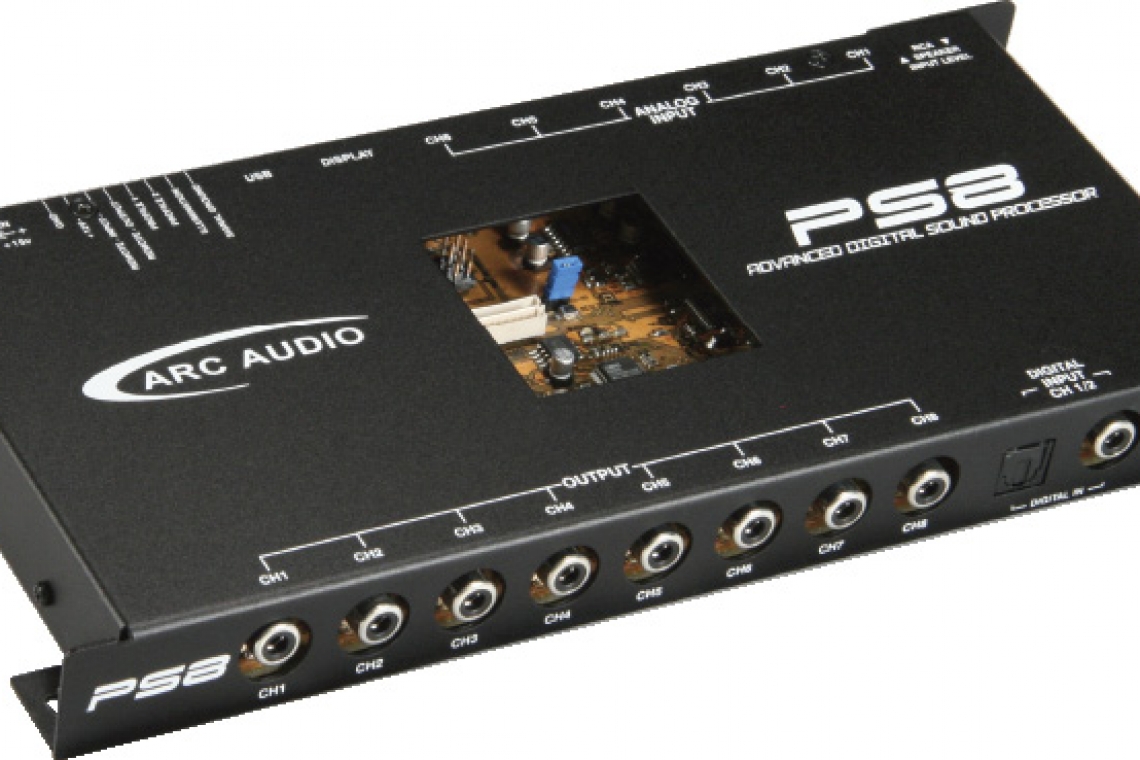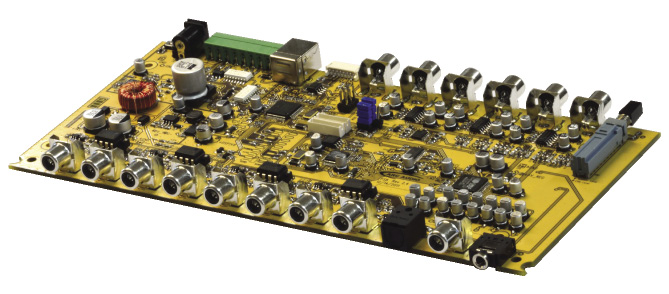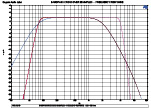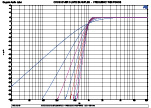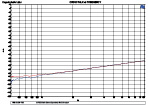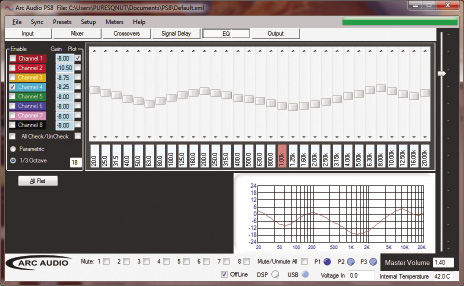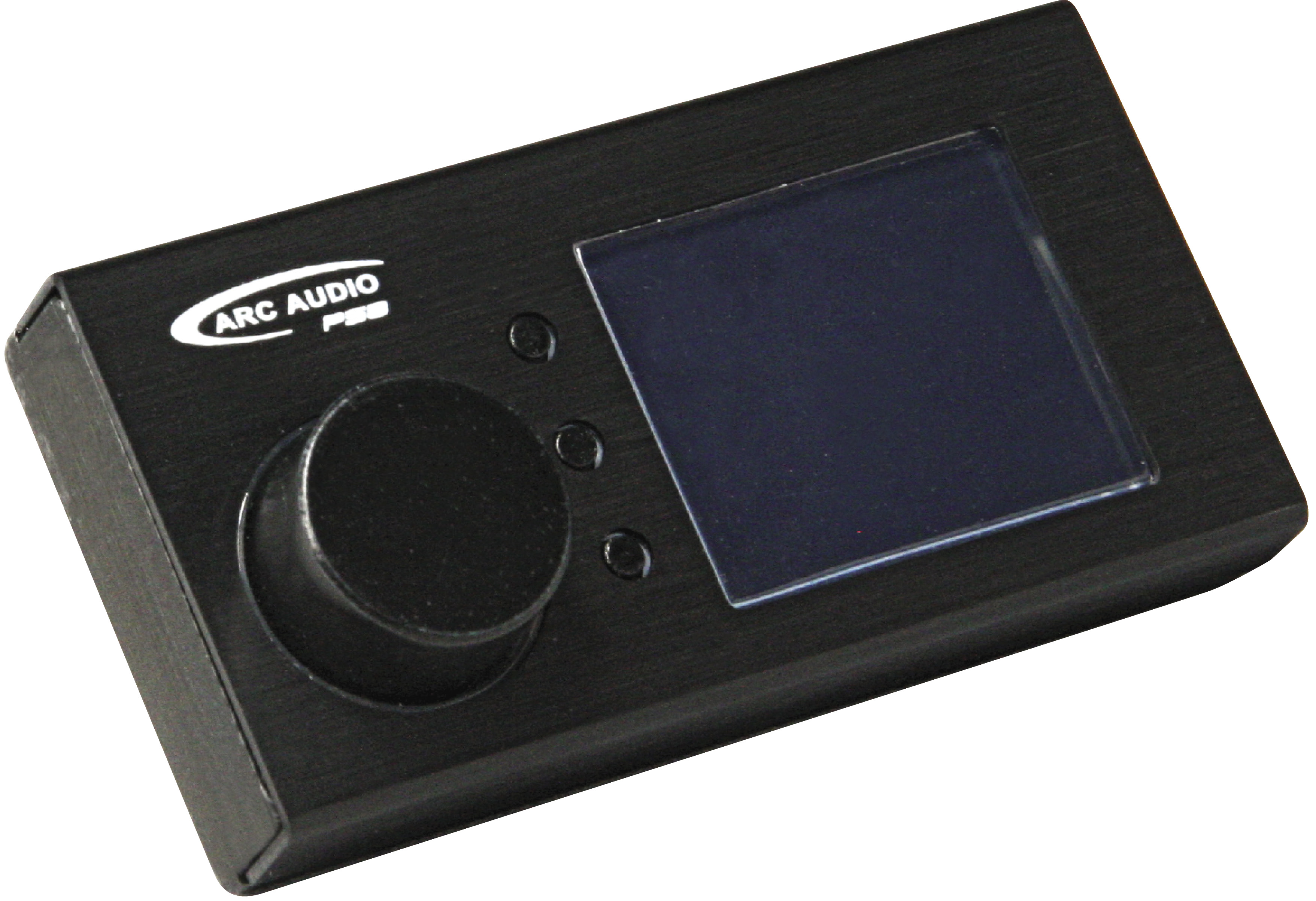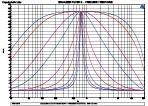At the last Consumer Electronics Show in Las Vegas, I had the opportunity to listen to many demo vehicles. One that really stood out and I spent a considerable amount of time listening to was the Saturn in Arc Audio's booth.
From the truly wonderful Black series speakers to amplification, Arc Audio's Fred Lynch gave me the complete rundown on the brilliant-sounding system, the heart of which is the all-new ultra high-end signal processor called the PS8. I asked Lynch for more details on the PS8 and what I learned was nothing short of jaw dropping.
The project's technical mastermind is none other than the illustrious audio industry engineer Robert Zeff, who has nothing to prove when it comes to designing great sounding gear. Zeff's technical prowess combined with Lynch's extensive experience tuning high-end and competition cars has resulted in a product that boasts an especially-good blend of performance, adjustment power and simplicity of use.
Of course, I simply has to finagle one for review and Lynch was kind enough to fly out to Phoenix and personally deliver one of the first production samples to my lab. We went through the processor and it's rather remarkable software together. This review is the result of what I've seen, heard and learned.
Allow me to preface this by saying there's absolutely no way I can even begin to do justice to all the features, tricks, innovations and cool things the PS8 does in a magazine review. However, I'll do my best to give you a taste of what it can do.
INTRODUCTION
The PS8 is a relatively small black box type of product controlled and adjusted primarily by a laptop computer connected by USB cable. I say primarily because there are provisions to change settings and configurations with on-board switches as well that allow certain functions to be adjusted from the driver's seat without requiring a PC.
The PS8 is not your typical DSP processor. It has been designed to be used as a solution for several quite different applications from OEM interfacing and fundamental system tuning and control to expert level tuning perfectly suited to the highest performance audiophile competition class systems. The feature set below describes the basic characteristics and functions built into the core DSP circuitry:
- High-performance audio optimized with a 32-bit DSP.
- 300,000,000 MAC/S (multiply accumulates per second).
- Dual MAC cycles per clock.
- Dual 72-bit accumulators (the most accurate in the industry).
- 24,000 x 32 SRAM, 2,000 blocks (assignable to data or program).
- Internal watch-dog DSP lock-up prevention.
- Maximum 32-bit @ 192 kHz.
- Supports 32-bit audio sample I/O between DSP chips.
- 192 kHz SPDIF transmitter.
- Multi-channel DSD direct stream digital SACD input.
- Supports two different input Fs sample rates.
- Dual processing path capability.
- Codec / digital-to-analog converter 32-bit operation capable of 192 kHz.
- S/N ratio analog input 96 dBA.
- S/N ratio digital input 109 dBA.
- Dedicated dual 72-bit algorithm volume control processors.
- 170 MHz primary processing.
- 48-bit internal audio sequence processing.
As you can see, at the digital core is a high-performance, 32-bit, user-programmable, fixed-point DSP that's capable of performing two multiply-and-accumulate (MAC) operations per clock cycle. The DSP core has eight 72-bit accumulators, four X- and four Y-data registers and 12 index registers. Coupled to the DSP core is a flexible DMA engine, which can move data between peripherals such as the serial control port (SCP), digital audio input (DAI), digital audio output (DAO) or any DSP core memory, all without the intervention of the DSP.
Before I go into all of the features, functions and the dizzying array of adjustments this thing is capable of, now is a good time to tell you how good it sounds and measures. In addition to my 12-volt car audio addiction, I also do a lot of work with professional live sound and studio products and high-end home audio products. As a result, I've used many DSP products. Some are very good, and some are frankly lousy. How I differentiate between the two is to listen for digital artifacts or what I call “processed sound” and; in this regard, the Arc Audio PS8 is one of the most musical processors I've ever heard.
This black box is truly full of digital magic because when you listen to a properly-tuned system through the PS8, you have no idea the signal is being manipulated. This sort of transparency is the trademark of a truly high-performance processor and, the PS8 gets very high marks in this regard. Folks, this one sounds amazing mostly because you simply can't hear it.
The Arc Audio PS8 can be as easy- or as complicated-to-use as the operator wants. There are four distinct modes of operation: standard, OEM, intermediate and expert. In expert mode, the range of adjustments, settings and variables is truly staggering. Interestingly, expert mode is only accessible after accepting an electronic release of liability disclaimer and acceptance of the risks of using the power and features available. This special warning and waiver is incorporated into the software graphic user interface. The disclaimer pops up upon entering the mode and will not unlock until the user accepts the agreement. Expert mode is not supported by Arc Audio technical support for tuning advice, nor is how to tune with a specific feature – you are on your own in this mode, which is intended for highly-advanced and experienced users that know what they're doing. I strongly recommend this mode only be used by true experts and people who have been properly trained and understand the fantastic amount of tuning power available.
PERFORMANCE / BENCH MEASUREMENTS
From a more technical perspective, the PS8 is equally impressive with a truly formidable set of credentials on the test bench. It delivers over 8.5 volts on each output with an excellent output impedance of only 22 ohms. Signal-to-noise is always a tough spec on DSP-powered products, but thanks to the use of first-class components and engineering brilliance of Zeff, this processor has a S/N ratio better than -95 dBA at an output level of 4 Vrms. THD level is in the 0.005% range and stereo separation a phenomenal -88 dB! I could go on about the sound quality and the measured specs, but with so many features and expert user mode details, that's what we'll move on to.
PS8 FEATURES & MODULES
Auto Recovery USB (A.R.U.) technology
Designed and engineered specifically for the Arc Audio PS8 by Zeff, the A.R.U. technology allows for faults and cable issues, including accidental disconnect or damage, power failure or power loss on PC or in the vehicle, critical faults in USB communication and more without the processor locking up, losing unsaved settings or requiring a full reset. This key benefit allows users to simply reinstate the last known user-defined tuning position after a failure or power loss even if it hasn't been saved as a preset or setting file on the PC.
Real-time update and memory management
PC communication while in user interface mode updates in real time allowing you to hear and save every adjustment as it is made. User settings files are processed internally as data files rather than active audio files. In this manner, the PS8 can process the user-defined adjustments at a higher resolution without the traditional loss of bandwidth in the digital domain.
Four-stage audiophile switching power supply
The PS8 uses a dedicated proprietary four-stage switching power supply for the various critical digital and analog components. There's an isolated 14-volt power supply used specifically for the OLED display controller (sold separately) and op amps as well as dedicated power supply channels for the PS8's codec and DSP main chips. To prevent unwanted noise, special ground isolation circuitry eliminates the possibility of signal interference or induced noises between the PS8's analog and digital components, thus improving S/N ratio.
Arc Audio proprietary electronic unit identification protocol
Every PS8 DSP comes with discrete embedded processor identification and serial number that allows users and dealers to retrieve the unit's individual Arc Audio serial registration code. This security measure functions even if typical identifiers have been removed by unauthorized sellers or thieves. The serial registration and identification code is embedded into the PS8's microprocessor and is viewable by connecting to the PC interface.
Interchangeable output core technology
Audiophile-grade ultra high resolution Texas Instruments 5532 output devices improve the overall dynamic response and sound quality levels and enable the PS8 to provide the highest standards of audio reproduction. In an effort to support the audiophile community, the PS8 is equipped with zero insertion loss audio-grade IC dip sockets to allow the most critical of tweakers to interchange output devices to their device of choice. However, you're basically on your own if you do this as Arc Audio is not liable for damage or side effects caused by changing the factory 5532 output devices. Take my advice: leave the 5532s in there – op amps don't get much better.
Signal input stage and input compatibility
The PS8 includes six channels of RCA inputs capable of up to seven volts of signal. High-level inputs can be utilized via a supplied “pigtail” adaptor and pressing the input level switch, which also resets the input impedance from 10,000 ohms to 200 ohms. The high-level input network will accept up to about 20 volts of signal for most OEM integration applications.
Digital coaxial and fiber optic inputs
Priority-assignable digital coaxial and fiber optic inputs allow users to run at the highest level of acoustical reference on today's most advanced high-end source units. (Use of the digital input circuit requires an optional accessory controller.)
3.5 mm unbalanced signal input
A 3.5 mm input jack is included for auxiliary input sources such as portable music players or navigation devices. The input is assignable as a “navi” style input, which causes the PS8 to mute when it senses signal from this input for navigation voice commands. When this input is used, it disables the RCA input channels five and six and takes their position on the user interface signal router panel.
DSP-controlled remote turn-on circuit
To prevent unwanted pops and snaps caused by some components in the system turning on before or after others, the PS8 has a cleverly-designed DSP-triggered remote turn-on output technology to control the critical timing of your system amplifiers' on and off sequences. User-defined controls allow you to define when amplifiers turn on and off through the PC interface from one millisecond to 10 seconds after the source unit is turned on.
Preset interface trigger
To enable the toggling between three separate user-defined presets, the PS8 provides a trigger lead, which allows users to toggle though settings with vehicle-mounted toggle switches without the need of the controller or PC interface.
DC barrel jack power connection for home use.
The PS8 offers a built-in DC barrel jack on the power terminal side of the main unit. This feature allows users to use the PS8 as a home audio DSP processor by simply plugging in a properly-rated AC/DC power supply.
Bluetooth expansion module
The PS8 has advanced Bluetooth communications provisions offering a wide variety of additional source and control applications for the PS8. The PS8BTM expansion module (sold separately) allows users to stream audio from portable MP3 players or media storage devices into the PS8; and, use the PS8 and media devices as sources (optional PS8 control station required). The PS8BTM expansion module is Bluetooth 2.1 compliant and is a CE, IC and FCC qualified registered product. It has a range of up to 30 meters (depending on application and installation of the PS8 unit) and can support up to 14 simultaneous Bluetooth profiles. All of this wireless voodoo magic works via an on-board proprietary integrated antenna.
User-definable channel labelling, naming and function assignment
User-defined channel name assignment capability allows you to customize the names of all input and output channels with up to 10 characters each. These names are then represented on the input screen, crossovers, equalizer, signal delay, output levels et al.
VU meters
My favorite feature (and something that comes in very handy when tuning) has to be the on-board VU meters in the software. These individual channel meters offer users the ability to view signal levels within the PS8 and multiple points in the signal chain. The signal input VU meter allows users to view the incoming signal in real time, including clipping level and independent channel level of all inputs. An output VU meter allows users to visualize the signal levels through the PS8, post mixer/router, crossover, equalizer, signal delay et al helping ensure the channel assignments are correct and that there's no internal clipping of any of the individual DSP component sections before the output stage. The signal output VU meter allows users to see the signal of all individual channels as they leave the DSP into the PS8's output stage allowing users to use the signal output trim panel to adjust each channel for optimum signal whilst avoiding signal clipping or unwanted distortion.
Full-time system channel muting control
For ease in tuning, the PS8 offers users full-time independent channel or full system muting from any interface panel of the PS8's software utility without having to change screens or functions to access this panel.
One-step firmware update
When the PS8 is connected to the internet via a PC, users can quickly check for updates for the DSP and controller by simply pressing the “Check for Firmware Updates” button. This also automatically turns the user's computer into a network station without ever requiring the user to locate password or login info and electronically connects the PS8 with Arc Audio's server. Upon accessing the server, the current PS8 operating system is verified before the main unit firmware (as well as the controller's firmware) is updated to the latest versions.
The whole process of firmware and system updates averages about 60 seconds and does not require external power supplies. Plus, thanks to a built-in fail-safe protocol, there's no risk of catastrophic consequences should the update process be interrupted for any reason. Lynch demonstrated this for me by first unplugging the USB cable during an update (and then removing the battery from his laptop during a subsequent demonstration) and the system simply returned to its previous state with no lock-ups, crashes or anything. Astonishingly, it just worked perfectly no matter what stupidity we tried throwing at it.
World Wide Web tech support
The PS8 PC interface allows Arc Audio to take technical support to a whole new meaning. Thanks to Web-based technical support that can be connected directly to your PS8 hardware anywhere in the world, the tech support person can take control of it via the Internet from Arc Audio's main headquarters. This remote control capability allows the support staff to quickly and easily diagnose and correct problems without an endless barrage of questions.
PS8 EXPERT MODE TUNING FEATURES
Input signal menu and capabilities
- Adjustable input signal level per individual channel.
- Variable adjustability of input signal from -64 dB to -/+24 dB in 0.25 dB per step increments per individual channel.
- User-defined auto sense priority interface (lets users choose what input source to default to if the main unit senses the signal – such as defaulting to Bluetooth from normal analog RCA operation).
- Analog – RCA and 3.5 mm inputs operation only.
- Digital – Coaxial, optical and Bluetooth (requires PS8BTM module and controller).
- Wired lead input/output status.
Signal path mixer/router panel and capabilities
- Input/output-configurable channel assignment.
- 100% fully open fully variable mixer panel controls allows user to define the signal path from any input channel to any output channel.
- All mixer/router channel in/out assignments are fully variable allowing users to select any level of input signal to its out channel assignment for stereo, mixed stereo, mixed mono, sum mono signal assignments and more.
- User-friendly sum/mono button allows users to combine any input combination of paired channels into a single 100% un-clipped summed mono signal for subwoofer applications.
- Numerical value displays for all possible assignment paths.
- User adjustments can be made by manual entry, mouse pointer via dial control, double key stroke (channel on and off) or intuitive arrow key controls.
- Individual 180-degree signal phase invert on all eight output channels.
Crossover settings panel
- Eight channels out fully variable type crossovers: all pass, high pass, low pass, band pass.
- Fully-open architecture crossover slopes allow users to select any variation of slope on any filter type with the capability of different slopes on both HP and LP portions of BP configuration.
- User-defined damping selection on all bands of all channels at six, 12, 18, 24, 30, 36, 42 and 48 decibels (allowing users to select any variation of slope on any filter type with abilities for different slopes on both HP and LP portions of BP configuration).
- User-defined damping options on all bands of all channels, including Butterworth, Linkwitz-Riley, Bessel and variable “Q” function.
- User-defined variable frequency selection on every band of every channel from 20 Hz through 20 kHz with incredible frequency definition (such as 6,523.43 Hz if so desired).
- Slider, keyboard arrow key and numerical entry options for all crossover settings.
- User-defined frequency limitations platform to prevent adjustments being made below defined frequency points and prevent damage to speakers during the tuning process.
- User-defined input signal zero- to 180-degree phase invert on all six input channels.
- User-selectable output signal zero- to 180-degree phase invert on all eight output channels.
Possible crossover variations
- 1,999,800 crossover frequency points per type, per channel.
- 3,996,000 possible crossover frequency points per channel.
- 31,968,000 possible crossover points on the PS8 across eight output channels.
- Over 4,000,000,000 possible crossover types and configurations on the entire PS8.
Phase/signal delay panel
- Eight channels of user-defined signal delay.
- Delay capability of up to 10 milliseconds per channel (adjustable in 0.01 ms increments).
- Numerical display readout on all channels for real-time delay status.
- Slider, keyboard arrow key and numerical entry options for all delay settings.
- Global/relative likability of any combination of channels (allows user to adjust the delay on each channel individually and then in pairs or all globally without the loss of an individual channel's previous settings).
- Individual 180-degree signal phase invert on all eight output channels
Output signal panel
- User-adjustable signal levels on each channel have zero through -40 dB of attenuation (allowing user to reduce signal output for driving amplifiers that cannot accept high-level signal input and for advanced system calibrations).
- There are also front + rear, left + right, center and bass level assignable faders accessible on this panel for even more defined tuning and level settings with the optional PSC controller.
Equalization panels
One-third octave equalizer
- Eight channels of 31-band third-octave equalization per channel.
- Traditional third-octave EQ points from 20 Hz to 20 kHz.
- Adjustable in 0.25 dB per step increments (each band per channel adjustable to +/- 24 dB).
- Global/relative/individual likability of any combination of channels allowing users to adjust the EQ on each channel individually and then in pairs or globally without the loss of the previous individual channel's settings.
- EQ channel plotting available on one or all eight channels simultaneously.
Parametric equalizer
- Eight channels of fully-open architecture parametric equalization.
- User-defined parametric equalization from one to 31 bands per channel.
- User-defined frequency centers on all 31 bands of each of the eight channels selectable from from 20 Hz to 20 kHz (any frequency including 16th/octave harmonic frequencies and mid tones).
- User defined "Q" on all user defined and factory frequencies on all channels.
- “Q” adjustable from 0.1 to 24 allowing users the opportunity to select “Q” variations from very wide to extremely sharp EQ points (for applications such as 31 bands of EQ notch filters on every channel if so desired).
- Adjustable in 0.25 dB per step increments (each band per channel adjustable to +/- 24 dB).
- Global/relative/individual likability of any combination of channels allowing users to adjust the EQ on each channel individually and then in pairs or globally without the loss of the previous individual channel's settings.
- EQ channel plotting available on one or all eight channels simultaneously.
Related Articles
 Acura To Bring Back The RSX… Sort Of
Acura To Bring Back The RSX… Sort Of
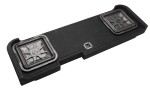 KICKER Under-Seat Loaded Enclosures for Ford, GMC, Chevy, RAM
KICKER Under-Seat Loaded Enclosures for Ford, GMC, Chevy, RAM
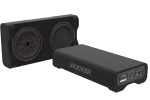 Understanding Audio Radiators w/ KICKER
Understanding Audio Radiators w/ KICKER
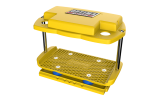 OPTIMA Batteries - Battery Mounts
OPTIMA Batteries - Battery Mounts
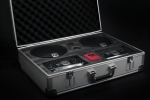 MB Quart Q Series Speakers
MB Quart Q Series Speakers
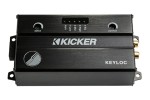 KICKER KEYLOC Smart Line-Out Converter
KICKER KEYLOC Smart Line-Out Converter


